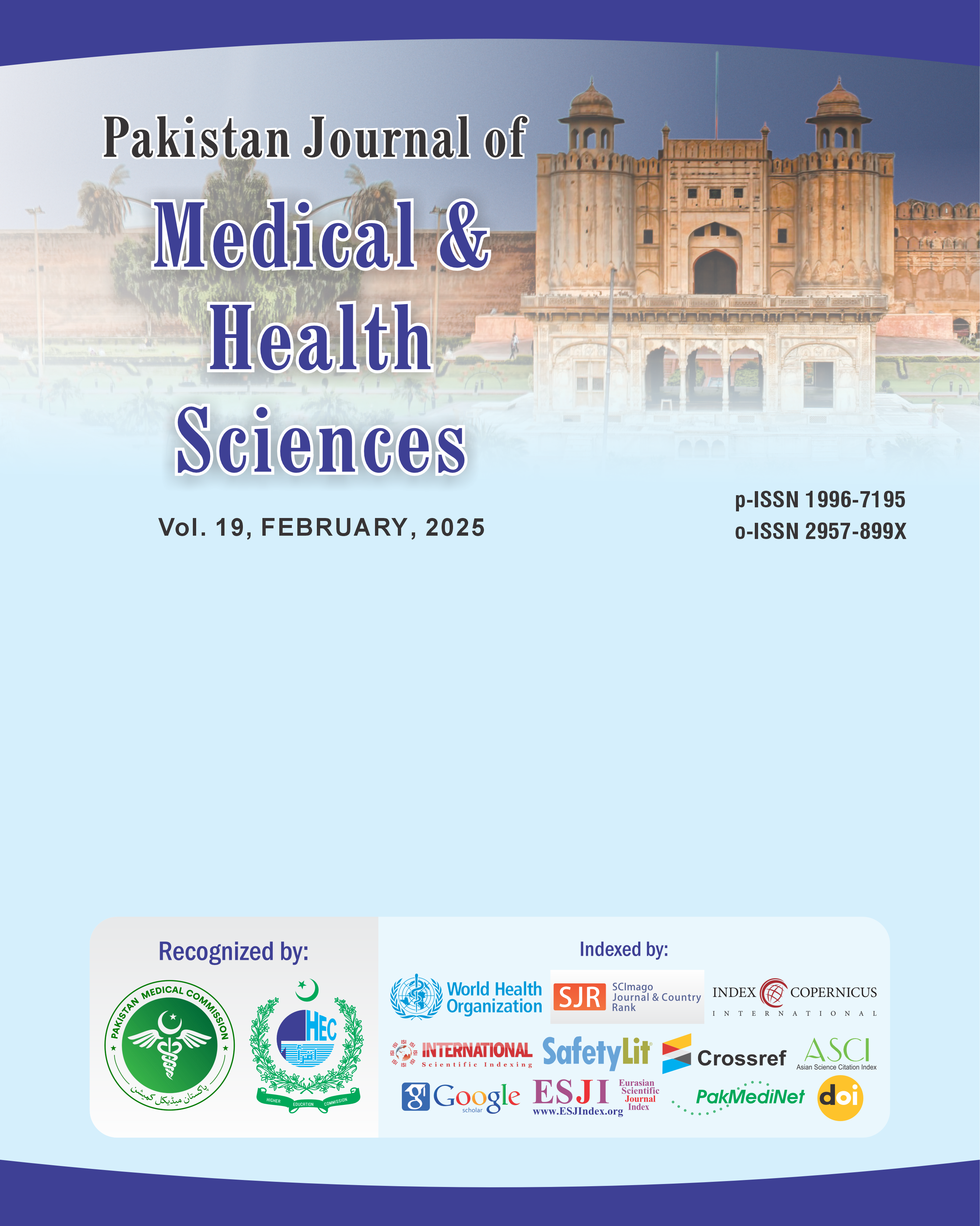Examining Legal Recourse and Rehabilitation for Burnt Survivors of Domestic Violence: A Study of Section 337-L (1) in Pakistan
DOI:
https://doi.org/10.53350/pjmhs02025192.7Keywords:
Domestic Violence, Physiological Outcomes, Hospitalization, Survivor-Centered Care, Trauma-Informed Approach.Abstract
Background: The section 337-L (1) of the Pakistan Penal Code serves as a pivotal legal instrument, providing a framework for addressing injuries for disturbing normal pursuits of life for about 20 days or more. In this context burns inflicted within the realm of domestic violence surfaces as the most notorious mode of injury to be evaluated in light of this particular section of law.
Aim: To identify the correlation between physiological outcomes and the length of hospital stay of survivors of unfortunate victims of burns.
Methodology: Data were collected from Accident and Emergency Department of May Hospital Lahore from December 2023 to December 2024. Physiological outcomes were assessed including scar, movement limitation, disfigurement, loss of feeling of sensation and permanent pain or discomfort; participants were categorized based on gender and age group. Statistical analysis was carried out to find the relation between the return to normal physiology when compared with the one of longer hospital stay.
Results: The results showed strong correlations between burns and some physiological outcomes, such as scarring, motion impairment and permanent pain or discomfort in survivors. Physiological outcomes were correlated with the severity of prolonged hospitalization, reflecting the limitations of survivors in receiving timely and comprehensive healthcare services. The p value 0.009 found the association defined to be statistically grossly significant.
Conclusion: present study demonstrated the urgency to tackle burns through holistic and survivor centered approaches of early detection, trauma informed care, and integrated support services. When healthcare systems prioritize the well-being of survivors and encourage interdisciplinary collaboration, they can contribute to mitigating the ravages of burns and help survivors heal and recover.
References
Kishawi, D., A.W. Wozniak, and M.J.J.B. Mosier, TBSA and length of stay impact quality of life following burn injury. 2020. 46(3): p. 616-620.
Jawad, A.M., et al., Recovery of Functional Independence following Major Burn Survival: a Systematic Review. 2024.
O'Brien, K.H.J.B., Dimensions of burn survivor distress and its impact on hospital length of stay: A national institute on disability, independent living, and rehabilitation research burn model system study. 2020. 46(2): p. 286-292.
Bayuo, J., F.K.Y.J.J.o.B.C. Wong, and Research, Intervention content and outcomes of postdischarge rehabilitation programs for adults surviving major burns: a systematic scoping review. 2021. 42(4): p. 651-710.
Żwierełło, W., et al., Burns: classification, pathophysiology, and treatment: a review. 2023. 24(4): p. 3749.
Palackic, A., et al., Rehabilitative exercise training for burn injury. 2021. 51(12): p. 2469-2482.
Jeschke, M.G., et al., Burn injury. 2020. 6(1): p. 11.
Deng, H., et al., A Narrative Review of Outcomes in Burn Rehabilitation Based on the International Classification of Functioning, Disability, and Health. 2023.
AYMAN, A.E., et al., Impact of Psychological Rehabilitation on Healing of Burn Patients. 2021. 89(September): p. 1471-1479.
Wang, B.B., et al., Adolescents with and without head and neck burns: comparison of long-term outcomes in the burn model system national database. 2022. 48(1): p. 40-50.
Lodha, P., et al., Post-traumatic stress disorder (PTSD) following burn injuries: a comprehensive clinical review. 2020. 33(4): p. 276.
Wiechman, S.A.J.H.o.B.V.R. and Rehabilitation, Long-Term Outcomes Following Burn Injuries. 2020: p. 15-23.
Swain, S.K.J.I.J.o.C.P., Facial burn in children: a review. 2024. 11(1): p. 94.
Agiananda, F., I.J.S.b.S.-I.B. Kusumadewi, and T. Aspects, The Role of Mental Health Professionals in Burn Centers and Units. 2021: p. 217-229.
Bergeron, N., et al., Mental Health in Burn Survivors. 2021: p. 147-164.
Alzahrani, H., et al., Relationship of Substance Abuse and Living Situation on Burn Survivors. 2022.
Downloads
How to Cite
Issue
Section
License
Copyright (c) 2025 ZULFIQAR ALI BUZDAR, SYED NAVEED HAIDER, SHEEBA SHABBIR, ROMAN ASHRAF, FAKHARUZ ZAMAN, RIFFAT MASOOD

This work is licensed under a Creative Commons Attribution 4.0 International License.


